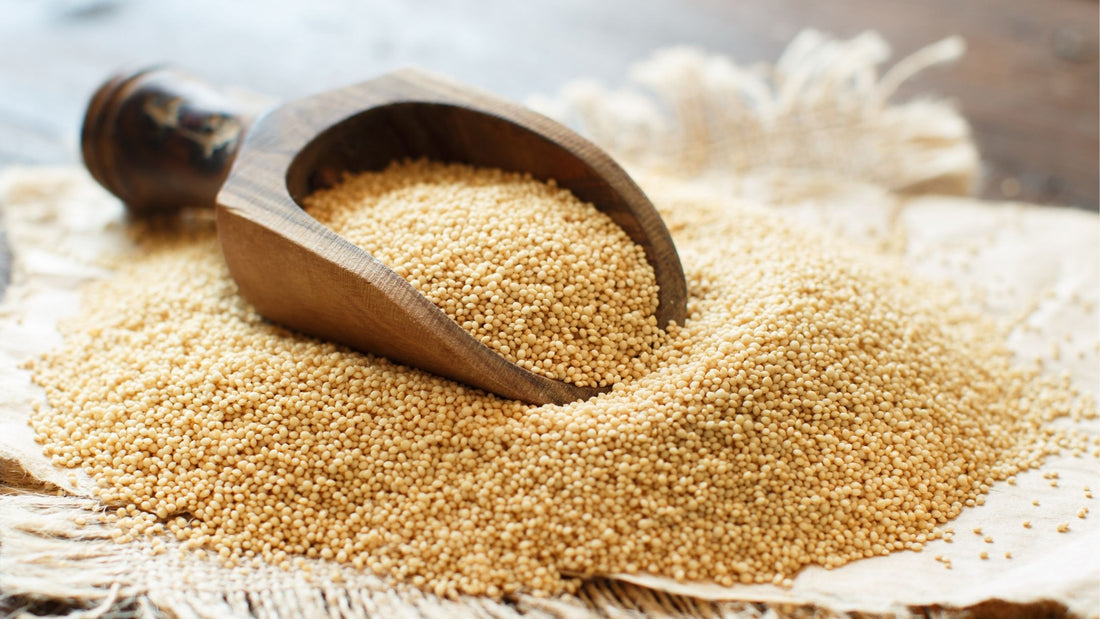
Amaranth Grains : Health Benefits & How To Cook
Naturally YoursShare

This healthy grain was a staple food of the Aztecs and an integral part of Aztec religious ceremonies.
Amaranth can be popped like popcorn and then mixed with honey, or even served with milk, dry fruits and nuts too. It can also be used to extract Amaranth oil.
HEALTH BENEFITS OF AMARANTH
Super food Amaranth is Super healthy!!
1. Gluten free- A great alternative to wheat flour for those who want to go gluten free or to those with Celiac disease or Gluten sensitive enteropathy. It can be used as a thickening agent in soups, sauces, porridges and stews
2. Reduces Inflammation- Amaranth contains anti-inflammatory properties which reduces body’s production of immunoglobulin E, thus reducing pain and inflammation significantly!
This is especially important for chronic conditions where inflammation detoriates your health like diabetes, heart diseases, Blood pressure or stroke.
3. Lowers Cholesterol levels- The oils and phytosterols in amaranth helps lower LDL, Triglycerides.
4. Good source of proteins- As mentioned below, 1 cup amaranth contains about 10gms of protein. This protein is highly bioavailable, making it more digestible and absorbing.
5. Reduces the risk of developing cancer- Amaranth is rich in peptides and anti-oxidants which provide protection against inflammation, thus preventing Cancer.
6. Helps in Digestion- These tiny seeds contain high fibre making it filling and aids digestion too. Fibre is also helpful for controlling blood pressure, cholesterol and reduces sugar absorption. Insufficient fibre is linked to constipation, gases, bloating and increased Fat storage.
7. Important minerals- Amaranth is loaded with Calcium, magnesium, copper, zinc, phosphorus and potassium. These minerals are required for building strong muscles and bones, for improving body hydration, preventing Anaemia, and for improving energy levels too!!
8. Healthy skin- Amaranth contains your daily dose of Vitamin C, which is vital for skin, maintaining collagen and also reduces sign of ageing.
Amaranth oil can also be used for minor injuries like sprain and specific skin issue
9. Healthy Hair- The unique chemical makeup of amaranth grain has some rather unexpected benefits as well, which includes increasing lustre and shine to hair when consumed in your diet.
NUTRIENT COMPOSITION OF AMARANTH (UNCOOKED)
Nutrient values per 100gms
CARBOHYDRATES 65gm
OF Which Sugars 1.7gm
Dietary fibre 7gm
FAT 7gm
PROTEIN 14gm
VITAMINS QUANTITY %Daily Values
Thiamine (B1) 0.1mg 9%
Riboflavin (B2) 0.2mg 17%
Niacin (B3) 0.9mg 6%
Pantothenic acid (B5) 1.5mg 30%
Vitamin B6 0.6mg 46%
Folate (B9) 82mcg 21%
MINERALS QUANTITY %Daily Values
Calcium 159mg 16%
Iron 7.6mg 58%
Magnesium 248mg 70%
Manganese 3.4mg 162%
Phosphorus 557mg 80%
Potassium 508mg 11%
Zinc 2.9mg 31%
Water 11gm
HOW TO STORE AMARANTH?
To keep Amaranth for a long period of time, it is best to seal it an airtight container.
If you want to use amaranth as a flour, you can grind it in a food processor and freeze the result. It will stay fresh for 6 to 9 months in a freezer.
THERE ARE PLENTY OF WAYS TO ENJOY AMARANTH AS A PART OF YOUR DAILY DIET:

Amaranth grains can be added in various dishes as a vital ingredient to bring out the flavour, aroma and taste of the grain.
1. Pop dry amaranth like popcorn and eat it as a snack. However, its not going to look like the big, fluffy popcorn you are used to, but worth including in your diet
2. Boil whole Amaranth grain in a 3:1 ratio of water to water and make it as a porridge
3. Roast Amaranth flour in ghee, add milk, jaggery, cinnamon powder and your yummy healthy porridge is all set and ready. Excellent breakfast option for toddlers and elderly too.
4. Put Popped amaranth on salads, yogurt or in soups
5. Blend Amaranth into a smoothie for a nutty flavour
6. You can add amaranth to rice or khichdi’s for a protein boost
7. You can make Bhakris or multigrain chapatis mixing Amaranth flour with wheat flour.
8. You can make delicious amaranth tikkis/ cutlets by mixing amaranth with bread crumbs
9. Popped Amaranth can also be mixed with something sweet and sticky like honey or molasses in order to make a healthy homemade snack bar
10. How can I forget the very well-known Amaranth/ Rajgeera chikki which is popular and easily available!
Thus, its easy to see why, Amaranths nutty, pleasant sweet flavour and its versatility makes it a perfect choice for many recipes.TO SUM UP-
Even though Amaranth has existed for a long time, it has gained popularity among people in recent times due to its nutrient rich qualities.
Its utmost speciality is that it is gluten-free and allows a whole lot of gluten intolerant people to include Amaranth in their diet.
Best of all, this grain is easy to prepare and can be added to a variety of dishes, making it an excellent addition to your diet.
REFERENCES-
Amaranthus Caudatus L. – Drug information Portal (internet). Druginfo.nlm.nih.gov.2019 (Cited 19 June 2019)
Caselato-Sousa VM, Amaya- Farfan J. State of knowledge on amaranth grain; Journal of Food science. 2012 Apr; 77 (4): R 93-104 (Citied 19 June 2019)
Trending Articles
1) What to eat when - Read Now
2) Healthy ways to satisfy your sweet tooth - Read Now
3) Morning habits to help you lose weight - Read Now
ABOUT THE AUTHOR

Sneha Jain, Dietician
Sneha is a Post graduate with specialization in Nutrition and Dietetics. She is a university topper and holds 5+ years of experience in Apollo hospitals, VLCC, slimsutra and first cry fit-kids .
She has successfully counselled clients all over India for weight loss, weight gain, diabetes, hypertension, PCOD, hypothyroid, Pregnancy and lactation and growth charts for children. She has her own diet consultation e-clinic (diet_diariez)
She believes in customized diets and eating local and seasonal foods. Her counselling not only involves diet planning, but also lifestyle modification and stress relief strategies.



